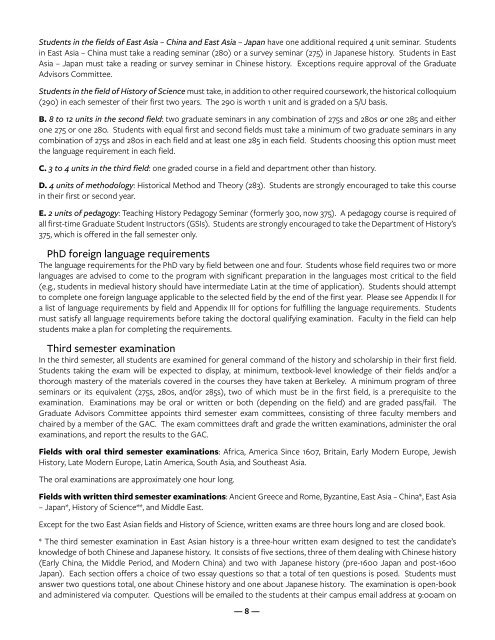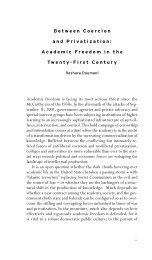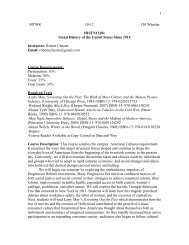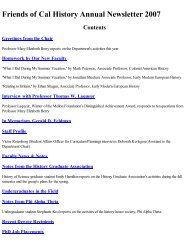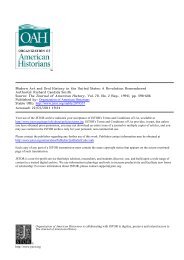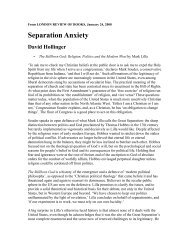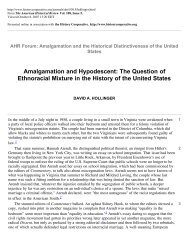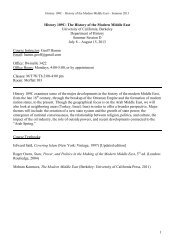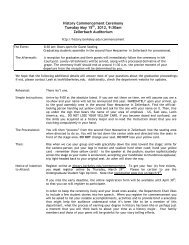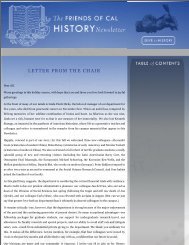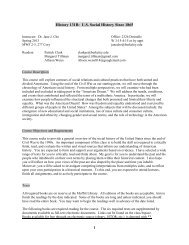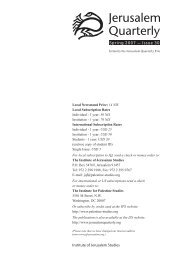Program Guide in PDF Format - Department of History, UC Berkeley
Program Guide in PDF Format - Department of History, UC Berkeley
Program Guide in PDF Format - Department of History, UC Berkeley
- No tags were found...
You also want an ePaper? Increase the reach of your titles
YUMPU automatically turns print PDFs into web optimized ePapers that Google loves.
Students <strong>in</strong> the fields <strong>of</strong> East Asia – Ch<strong>in</strong>a and East Asia – Japan have one additional required 4 unit sem<strong>in</strong>ar. Students<strong>in</strong> East Asia – Ch<strong>in</strong>a must take a read<strong>in</strong>g sem<strong>in</strong>ar (280) or a survey sem<strong>in</strong>ar (275) <strong>in</strong> Japanese history. Students <strong>in</strong> EastAsia – Japan must take a read<strong>in</strong>g or survey sem<strong>in</strong>ar <strong>in</strong> Ch<strong>in</strong>ese history. Exceptions require approval <strong>of</strong> the GraduateAdvisors Committee.Students <strong>in</strong> the field <strong>of</strong> <strong>History</strong> <strong>of</strong> Science must take, <strong>in</strong> addition to other required coursework, the historical colloquium(290) <strong>in</strong> each semester <strong>of</strong> their first two years. The 290 is worth 1 unit and is graded on a S/U basis.B. 8 to 12 units <strong>in</strong> the second field: two graduate sem<strong>in</strong>ars <strong>in</strong> any comb<strong>in</strong>ation <strong>of</strong> 275s and 280s or one 285 and eitherone 275 or one 280. Students with equal first and second fields must take a m<strong>in</strong>imum <strong>of</strong> two graduate sem<strong>in</strong>ars <strong>in</strong> anycomb<strong>in</strong>ation <strong>of</strong> 275s and 280s <strong>in</strong> each field and at least one 285 <strong>in</strong> each field. Students choos<strong>in</strong>g this option must meetthe language requirement <strong>in</strong> each field.C. 3 to 4 units <strong>in</strong> the third field: one graded course <strong>in</strong> a field and department other than history.D. 4 units <strong>of</strong> methodology: Historical Method and Theory (283). Students are strongly encouraged to take this course<strong>in</strong> their first or second year.E. 2 units <strong>of</strong> pedagogy: Teach<strong>in</strong>g <strong>History</strong> Pedagogy Sem<strong>in</strong>ar (formerly 300, now 375). A pedagogy course is required <strong>of</strong>all first-time Graduate Student Instructors (GSIs). Students are strongly encouraged to take the <strong>Department</strong> <strong>of</strong> <strong>History</strong>’s375, which is <strong>of</strong>fered <strong>in</strong> the fall semester only.PhD foreign language requirementsThe language requirements for the PhD vary by field between one and four. Students whose field requires two or morelanguages are advised to come to the program with significant preparation <strong>in</strong> the languages most critical to the field(e.g., students <strong>in</strong> medieval history should have <strong>in</strong>termediate Lat<strong>in</strong> at the time <strong>of</strong> application). Students should attemptto complete one foreign language applicable to the selected field by the end <strong>of</strong> the first year. Please see Appendix II fora list <strong>of</strong> language requirements by field and Appendix III for options for fulfill<strong>in</strong>g the language requirements. Studentsmust satisfy all language requirements before tak<strong>in</strong>g the doctoral qualify<strong>in</strong>g exam<strong>in</strong>ation. Faculty <strong>in</strong> the field can helpstudents make a plan for complet<strong>in</strong>g the requirements.Third semester exam<strong>in</strong>ationIn the third semester, all students are exam<strong>in</strong>ed for general command <strong>of</strong> the history and scholarship <strong>in</strong> their first field.Students tak<strong>in</strong>g the exam will be expected to display, at m<strong>in</strong>imum, textbook-level knowledge <strong>of</strong> their fields and/or athorough mastery <strong>of</strong> the materials covered <strong>in</strong> the courses they have taken at <strong>Berkeley</strong>. A m<strong>in</strong>imum program <strong>of</strong> threesem<strong>in</strong>ars or its equivalent (275s, 280s, and/or 285s), two <strong>of</strong> which must be <strong>in</strong> the first field, is a prerequisite to theexam<strong>in</strong>ation. Exam<strong>in</strong>ations may be oral or written or both (depend<strong>in</strong>g on the field) and are graded pass/fail. TheGraduate Advisors Committee appo<strong>in</strong>ts third semester exam committees, consist<strong>in</strong>g <strong>of</strong> three faculty members andchaired by a member <strong>of</strong> the GAC. The exam committees draft and grade the written exam<strong>in</strong>ations, adm<strong>in</strong>ister the oralexam<strong>in</strong>ations, and report the results to the GAC.Fields with oral third semester exam<strong>in</strong>ations: Africa, America S<strong>in</strong>ce 1607, Brita<strong>in</strong>, Early Modern Europe, Jewish<strong>History</strong>, Late Modern Europe, Lat<strong>in</strong> America, South Asia, and Southeast Asia.The oral exam<strong>in</strong>ations are approximately one hour long.Fields with written third semester exam<strong>in</strong>ations: Ancient Greece and Rome, Byzant<strong>in</strong>e, East Asia – Ch<strong>in</strong>a*, East Asia– Japan*, <strong>History</strong> <strong>of</strong> Science**, and Middle East.Except for the two East Asian fields and <strong>History</strong> <strong>of</strong> Science, written exams are three hours long and are closed book.* The third semester exam<strong>in</strong>ation <strong>in</strong> East Asian history is a three-hour written exam designed to test the candidate’sknowledge <strong>of</strong> both Ch<strong>in</strong>ese and Japanese history. It consists <strong>of</strong> five sections, three <strong>of</strong> them deal<strong>in</strong>g with Ch<strong>in</strong>ese history(Early Ch<strong>in</strong>a, the Middle Period, and Modern Ch<strong>in</strong>a) and two with Japanese history (pre-1600 Japan and post-1600Japan). Each section <strong>of</strong>fers a choice <strong>of</strong> two essay questions so that a total <strong>of</strong> ten questions is posed. Students mustanswer two questions total, one about Ch<strong>in</strong>ese history and one about Japanese history. The exam<strong>in</strong>ation is open-bookand adm<strong>in</strong>istered via computer. Questions will be emailed to the students at their campus email address at 9:00am on— 8 —


